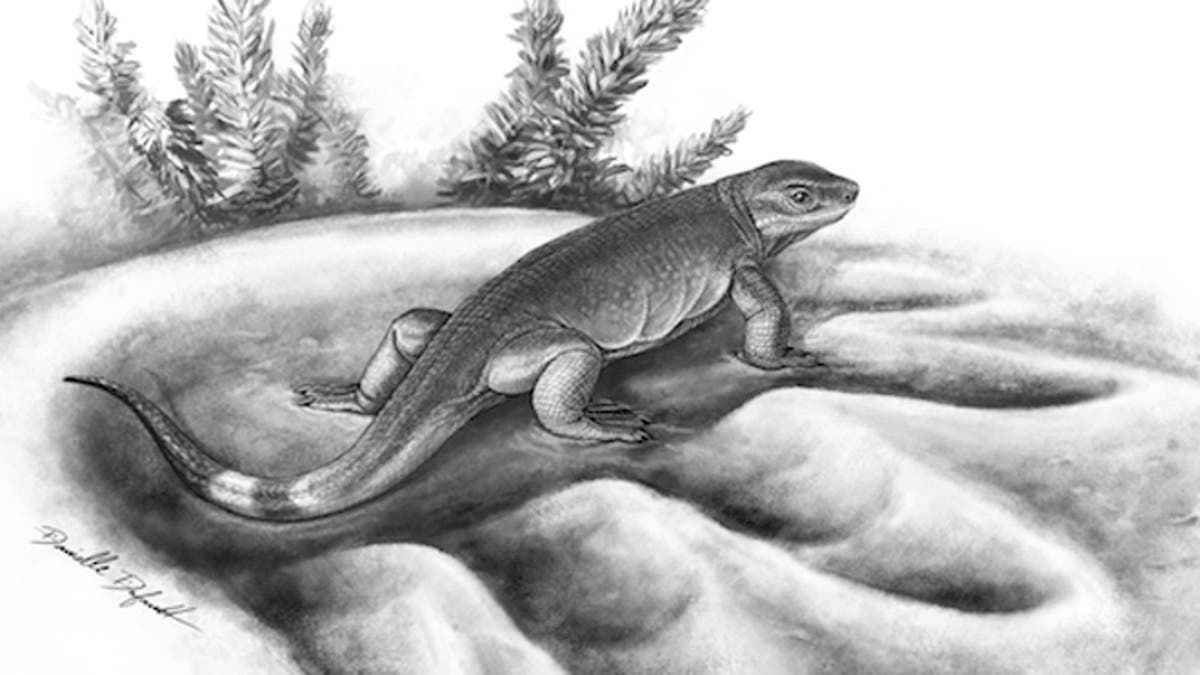
A reconstruction of 300 million-year-old tiny carnivorous Eocasea in the footprint of 270 million-year-old largest known herbivore of its time, Cotylorhynchus (Danielle Dufault)
The earliest ancestor of land-dwelling plant eaters has been found, a new study reports, and there's a surprising fact about the beastie: it was a meat lover.
If you often bite into a juicy steak, burger or other meat, you might wonder why such an animal would have transitioned to become an herbivore in the first place. The answer is that there was a lot of plant-based food for the taking.
Photos: What Did Prehistoric Humans Eat?
"The evolution of herbivory was revolutionary to life on land because it meant terrestrial vertebrates could directly access the vast resources provided by terrestrial plants," paleontologist Robert Reisz, a professor in the Department of Biology at the University of Toronto Mississauga, said in a press release. "These herbivores, in turn, became a major food resource for large land predators."
The newly discovered ancestor of the first terrestrial carnivores has been named Eocasea martinis. Its skeleton, which was just about 6.5 inches long, belonged to a juvenile that lived in what is now Kansas 300 million years ago. That's nearly 80 million years before the age of dinosaurs.
The researchers think the prehistoric animal feasted on insects and other small animals.
For the study, published in PLOS ONE, Reisz and colleague Jörg Fröbisch of the Museum für Naturkunde and Humboldt-University in Berlin compared Eocasea to skeletons for known related animals. They determined that Eocasea belonged to a certain branch (caseid) of the group Synapsid. This group, which consisted of both carnivores and herbivores, ultimately evolved into modern living mammals.
"Eocasea is one of the oldest relatives of modern mammals and closes a gap of about 20 million years to the next youngest members of the caseid family," Fröbisch said. "This shows that caseid synapsids were much more ancient than previously documented in the fossil record."
It's also the most primitive member of that group, with later members being plant lovers. This shows that large, land-living herbivores evolved from small carnivores. (I also love the extremes of that group. While Eocasea was small- sort of a munchkin pre-mammal from Kansas- later herbivorous members of the group could weigh over 1100 pounds.)
"Eocasea is the first animal to start the process that has resulted in a terrestrial ecosystem with many plant eaters supporting fewer and fewer top predators," Reisz said.
It's not that easy to digest and process high-fiber plant material, so evolving into a plant eater isn't something that can happen over night. The ability arose independently at least five times in the history of our planet, including twice in reptiles.
Prehistoric Carnivore Had ‘Steak Knife’ Teeth
"When the ability to feed on plants occurred after Eocasea, it seems as though a threshold was passed," Reisz said. "Multiple groups kept re-evolving the same herbivorous traits."
Reisz concluded that the discovery of Eocasea creates questions even as it answers them. "One of the great mysteries to my mind is: why did herbivory not happen before and why did it happen independently in several lineages? That's what's fascinating about this event. It's the first such occurrence, and it resulted in a colossal change in our terrestrial ecosystem."
